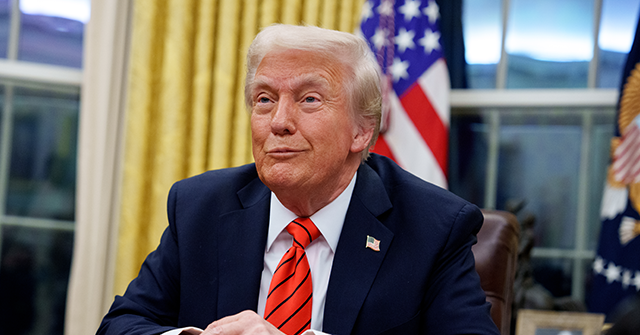Sorry, Tarifflationistas. The Data Just Proved You Wrong
For months, critics of President Trump’s tariff strategy have warned of an inevitable wave of inflation. That wave turned out to be a ripple, and it seems to have already ended.
The logic of the tarifflationistas sounded straightforward. They claim that if you raise tariffs on imported goods, consumers would pay more for everything. But new data from the Harvard Tariff Price Tracker tell a very different story. A year after the tracking began, prices do not show signs of tariff-induced increases. What’s more, the only meaningful price growth lately has come from goods completely untouched by tariffs.
The Harvard Tariff Price Tracker, built from the work of Harvard economists Alberto Cavallo, Gita Gopinath, and Brent Neiman, uses real-time online prices to isolate how tariffs affect different kinds of goods. The index divides products into three groups—imported goods directly affected by tariffs, domestic goods either in tariff-targeted product codes or in categories where imports dominate, and domestic goods in categories mostly unaffected by trade. By comparing how these move, the tracker offers one of the cleanest measures of what tariffs actually do to consumer prices.
The headline finding is straightforward: year-over-year inflation from tariffs is essentially zero. The tracker began in early October of 2024. By October 12, 2025, imported goods in tariffed categories had risen just two percent, almost exactly matching the Federal Reserve’s two percent inflation target. Meanwhile, domestic goods in tariff-affected categories had actually fallen 0.2 percent below their starting point. Domestic goods untouched by tariffs are up 1.4 percent. After a full year of Trump’s tariff regime, price levels across all three categories undermine the tariff-induced inflation narrative. Whatever inflation story tariffs were supposed to unleash never materialized.
Liberation Day Wasn’t an Inflationary Event
The timeline matters. President Trump announced his tariff package on April 2, 2025. Since that announcement, imported goods in tariffed categories have risen about 1.8 percent. Domestic goods in the tariff-affected categories have fallen roughly 1.0 percent from their pre-tariff levels, completely undercutting the narrative that domestic goods producers would raise prices as tariffs squeezed out foreign competition. And domestic goods untouched by tariffs are up about 1.5 percent. The picture is clear: import prices rose only modestly, domestic producers actually lowered their prices after tariffs took effect, and the prices of things completely unaffected by tariffs moved up almost as much as tariff-affected merchandise.
There was an increase in prices before April’s Liberation Day. From early February through the end of March, imported goods in tariffed categories rose 1.8 percent, while domestic affected goods prices rose two percent—nearly identical increases. Unaffected goods rose by a still significant one percent.
This period captured the initial 10 percent tariff on Chinese goods announced on February 4, followed by the March 4 escalation to 20 percent tariffs on China and 25 percent on Mexico and Canada. But the Mexico and Canada tariffs largely came off through USMCA exemptions—around 40 percent of Canadian exports and more than half of Mexican exports qualified for relief.
The similar movement across both affected categories in this period suggests markets may have been pricing in the tariff shock. But this is hard to determine because starting six months earlier, the Fed launched a series of rate cuts that reduced its target federal funds rate by one percent. Since monetary policy works with a lag, it is very possible that the price increases we saw in late winter of this year were caused by monetary easing. What’s more, consumers went on a spending spree in March of 2025, with real spending rising 0.7 percent in a single month. That too could have pushed up prices.
After April 2, when the broader “Liberation Day” tariffs took effect, the pattern changed. Import prices continued rising gradually while domestic prices in tariffed categories actually reversed course and began falling—a sign that competitive pressures, not tariff protection, were determining domestic pricing decisions.
Any Pass-Through Has Already Ended
Short-term trends are even more striking. Since the start of September, prices for imported goods are up less than one percent, while domestic affected goods have slipped slightly lower. Unaffected domestic goods rose about 0.8 percent over that same period—more than either of the tariff-exposed categories. That’s the opposite of what the conventional story predicts. Instead of tariffs rippling through the system and driving up costs everywhere, the data show the market has largely absorbed the initial shock.
In other words, the pass-through phase is over. Tariffs may have briefly nudged import prices higher, but those effects have stabilized. Domestic producers are now holding prices steady or lowering them, and the categories that were never subject to tariffs are seeing more price movement than the tariffed ones. The economy has adjusted to the new tariff regime and moved on.
The most compelling pattern is what happened to domestic producers. When tariffs were announced in April, conventional wisdom held that American companies would exploit their newfound protection from foreign competition by raising prices. They did the opposite. Domestic goods in tariffed categories have fallen since April. Rather than using tariffs as cover for price hikes, domestic producers faced continued competitive pressure and responded by keeping prices in check or lowering them outright.
The pundit class and their useful stooge brigade of academic economists never tire of the claim that tariffs raise prices, but the Harvard Tariff Price Tracker now provides real-time evidence to the contrary.
The supposed tariff-driven inflation never arrived. Importers absorbed some of the cost, domestic competition held prices down, and consumers barely noticed a difference. Year-over-year price levels are essentially where the Fed wants them to be. The categories most affected by tariffs show the least inflation today.
The bottom line: the tariff-inflation scare wasn’t just exaggerated—it’s over. The data say the shock passed months ago. Prices have settled near baseline. The market adapted. And the story that tariffs would ignite an inflation firestorm has gone the same way as so many elite predictions.
The post Breitbart Business Digest: The Tariff Inflation Scare Is Dead appeared first on Breitbart.




